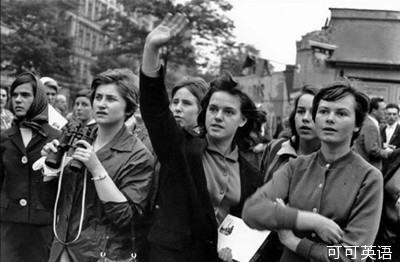(单词翻译:单击)
Books and Arts; A father of modern photography;The hunter and his prey;
文艺;现代摄影之父;猎手与猎物;
Henri Cartier-Bresson's photographs are on show in New York until June 28th;
亨利·卡蒂埃·布列松摄影展在纽约展出,截止到6月28日;
All it takes to be a photographer, Henri Cartier-Bresson once said, is “one finger, one eye and two legs”. He visualised photography as a way of engaging with the world. He quietly stalked his subjects—Balinese dancers, Mongolian wrestlers, New York bankers—until that “decisive moment” when the right composition filled the frame. It all came so naturally. He rarely used a light meter or checked his aperture setting, and he seldom took more than a few shots of a single subject. With the instinct of a hunter, he knew when to click the shutter: “I prowled the streets all day, feeling very strung-up and ready to pounce, determined to ‘trap' life—to preserve life in the act of living.”
亨利·卡蒂埃·布列松曾经说过,成为摄影师的必备条件不过是“一根手指、一只眼睛和两条腿”。他把摄影设想为接触世界的一种方式。他静静地走近拍摄对象-巴厘岛的舞者、蒙古摔跤手、纽约银行家-直到合适构图布满取景框的那个“决定性瞬间”。一切来的自然而然。他很少用曝光表,也不检查光圈,对拍摄对象拍不了几张照片。凭借猎手的直觉,他知道何时按下快门:“我整天在大街小巷漫步,觉得兴致勃勃,随时准备抓住机会,决定捕捉生活,在生活行为中珍藏生活。”

Born in 1908 in Paris, the eldest son of wealthy cotton-thread manufacturers, Cartier-Bresson had a lusty, rebellious hunger for travel. With a head full of Rimbaud and a copy of “Ulysses” under his arm, he set off for west Africa in search of adventure. (He aspired to be a painter, but Gertrude Stein suggested he drop the brushes.) He bought his first Leica in the Cote d'Ivoire when he was 23. Light and quiet, the camera had just come onto the market, and it was a revelation. It fitted into his pocket, along with a few rolls of film. “Nobody took pictures that were better at exploiting the portability of the camera,” says Peter Galassi, the chief curator of photography at the Museum of Modern Art in New York, where “Henri Cartier-Bresson: The Modern Century” is on view.
1908年生于巴黎的卡蒂埃·布列松是家境富裕的棉纱制造商的长子,对旅行充满强烈、难以抑制的渴望。满脑子兰波诗作的布列松夹着一本《尤利西斯》,踏上了去西非的探险之旅。(他曾经渴望当一名画家,不过著名画家格特鲁特·斯泰因劝他丢下画笔。)23岁的时候,布列松在象牙海岸买了第一台莱卡相机。这款相机刚刚投放市场,质地轻巧、噪音很小,实在出人意料。这台相机刚好放进他的口袋里,还有几卷胶卷。《亨利·卡蒂埃·布列松:现代百年》摄影展在纽约现代艺术博物馆展出,博物馆的摄影总监彼得加拉西说:“在开发相机的便携性方面,没有摄影者比他做得更好。”
The show, many years in the making, is drawn primarily from the huge archive of work held by the Henri Cartier-Bresson Foundation in Paris, founded a year before he died in 2004. From the thousands available, Mr Galassi has selected 300 images from 1929 to 1989, a fifth of which have never been seen publicly before.
本次摄影展筹备多年,展品主要来自巴黎亨利·卡蒂埃·布列松基金会的大量作品档案,该基金会于2004年布列松逝世前成立。加拉西从几千张照片中,精选了1929到1989年间的300张照片,其中五分之一从未公开露面。
As cameras grew smaller and picture magazines bigger, Cartier-Bresson became a globe-trotting hired hand. But though he had a knack for being in the right place at the right time—in India at the time of Gandhi's assassination, in China during the Cultural Revolution—he did not really have a nose for a good scoop. What he excelled at was seeing things in a different way from most other people.
照相机越来越小,摄影杂志越做越大,卡蒂埃·布列松成了奔波于全球的摄影家。尽管布列松有在合适时间、合适地点抓拍的窍门-在印度目睹甘地被刺,在中国碰上文化大革命-他却真的不善于挖掘独家新闻。他高人一等的地方,就是以不同于他人的方式观察事物。
The visitor is greeted by a wall of four photographs: a crowd of flag-waving, bespectacled Nixon-supporters in Texas in 1960 (the illustration above shows a couple of more sedate fans in Indiana); a cluster of Chinese youth gawking at a television in Beijing in 1958; a mass of French mourners in coats holding hands in 1962; and a group of wizened and rather menacing old men in Sardinia, lounging in straw-like grass, also in 1962. The juxtaposition of these images shows not just Cartier-Bresson's range but also his gift for group portraits. When snapping a spectacle—a coronation, say, or a parade—he trained his camera on the unsuspecting bystanders.
观众迎面看到的是四张照片的幕墙:1960年在德克萨斯州,一群尼克松的支持者挥舞旗帜、戴着眼镜(说明下面的插图是印第安纳州一对不苟言笑的支持者);1958年,一群中国年轻人在愣愣地看电视;1962年,许多穿着外套的法国送葬者手挽着手。1962年,撒丁岛上一群形容枯槁、面露凶相的老人在草地上游荡。这些照片齐聚一堂,不但显示卡蒂埃·布列松的题材广泛,还展现了他拍摄群像的才能。不论是加冕礼还是大游行,每拍摄一个场景,他都把照相机对准浑然不觉的芸芸众生。
The show is divided into sections, starting with some of Cartier-Bresson's most arresting surrealist work from the 1930s, such as a sunbather in Trieste, Italy, whose white body echoes a sliver of white in the grass, and his self-assured prostitutes in Mexico City. Then came the war (he was a prisoner in Germany for three years before escaping) followed by his career as photojournalist and portrait photographer.
这次摄影展分成几部分,开头是卡蒂埃·布列松20世纪30年代最引人瞩目的超现实主义作品,比如意大利蒂利亚斯特的日光浴者,她们的白皙身体和银白色草场相互呼应,还有墨西哥城满怀自信的妓女。接着是战时摄影作品(布列松在德国被囚禁了3年才逃脱),开创了他身为摄影记者和肖像摄影家的职业生涯。
There is much to marvel at, such as the pictures of China in 1948, which capture the photographer's powerful sense of formal composition. Some of the curator's choices seem a bit odd and the written descriptions, which add little, are occasionally heavy-handed. One section, for instance, is introduced as Cartier-Bresson's criticism of “American vulgarity, greed and racism”. But the visitor is left with a remarkable chronicle of the transformations of the 20th century—the rise of industrialisation, the fall of colonialism, the spread of commercialism and the grand-scale shift in world order—all captured by a lone man and his camera.
令人惊叹的还有这位摄影家强烈庄重的构图感,比如1948年在中国拍摄的照片。摄影总监对作品的选择看似有几分奇特,图片说明平添了一点尴尬。例如,有一个部分介绍了卡蒂埃·布列松对“美国人的粗俗、贪婪和种族主义”的批评。观众对20世纪种种变化的非凡记录所震撼:工业化的崛起、殖民主义的衰落、重商主义的蔓延和世界秩序的天翻地覆,一切都被一个人和他的照相机收入眼底。


